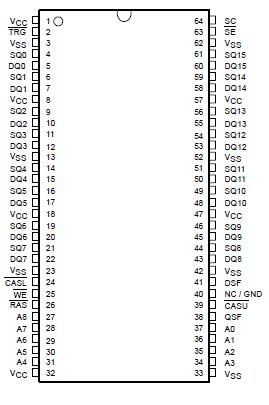Features: ` Organization:
DRAM: 262144 Words * 16 Bits
SAM: 256 Words * 16 Bits
` Single 5.0-V Power Supply (±10%)
` Dual-Port Accessibility Simultaneous and Asynchronous Access From the DRAM and Serial-Address-Memory (SAM) Ports
` Write-per-Bit Function for Selective Write to Each I/O of the DRAM Port
` Byte-Write Function for Selective Write to Lower Byte (DQ0DQ7) or Upper Byte (DQ8DQ15) of the DRAM Port
` 4-Column or 8-Column Block-Write Function for Fast Area-Fill Operations
` Enhanced Page Mode for Faster Access With Extended-Data-Output (EDO) Option for Faster System Cycle Time`CAS -Before-RAS (CBR) and Hidden Refresh Functions
` Long Refresh Period Every 8 ms (Maximum)
` Full-Register-Transfer Function Transfers Data from the DRAM to the Serial Register
` Split-Register-Transfer Function Transfers Data from the DRAM to One-Half of the Serial Register While the Other Half is Outputing Data to the SAM Port
` 256 Selectable Serial Register Starting Points
` Programmable Split-Register Stop Point
` Up to 55-MHz Uninterrupted Serial-Data Streams
` 3-State Serial Outputs for Easy Multiplexing of Video Data Streams
` All Inputs/Outputs and Clocks TTL Compatible
` Compatible With JEDEC Standards
` Designed to Work With the Texas Instruments (TITM) Graphics Family
` Fabricated Using TI's Enhanced Performance Implanted CMOS (EPICTM) ProcessPinout SpecificationsSupply voltage range, VCC (see Note 1) ...................1 V to 7 V
SpecificationsSupply voltage range, VCC (see Note 1) ...................1 V to 7 V
Voltage range on any pin .......................... 1 V to 7 V
Short-circuit output current ............................50 mA
Power dissipation .................................1.1 W
Operating free-air temperature range, TA ................ 0°C to 70°C
Storage temperature range, Tstg .................. 55°C to 150°C
† Stresses beyond those listed under "absolute maximum ratings" may cause permanent damage to the device. These are stress ratings only, and
functional operation of the device at these or any other conditions beyond those indicated under "recommended operating conditions" is not
implied. Exposure to absolute-maximum-rated conditions for extended periods may affect device reliability.
NOTE 1: All voltage values are with respect to VSS.DescriptionThe TMS55170 multiport video RAMs (VRAMs) are high-speed dual-ported memory devices. Each consists of a dynamic random-access memory (DRAM) organized as 262 144 words of 16 bits each interfaced to a serial-data register [serial-access memory (SAM)] organized as 256 words of 16 bits each. These devices support three basic types of operation: random access to and from the DRAM, serial access from the serial register, and transfer of data from the DRAM to the SAM. Except during transfer operations, these devices can be accessed simultaneously and asynchronously from the DRAM and SAM ports.
The TMS55170 multiport VRAMs provide several functions designed to provide higher system-level bandwidth and to simplify design integration on both the DRAM and SAM ports (see Table 2). On the DRAM port, greater pixel draw rates are achieved by the block-write function. The TMS5516x devices' 4-column block-write function allows 16 bits of data (present in an on-chip color-data register) to be written to any combination of four adjacent column-address locations, up to a total of 64 bits of data per CAS x cycle time. Similarly, the TMS5517x devices' 8-column block-write function allows 16 bits of data to be written to any combination of eight adjacent column-address locations, up to a total of 128 bits of data per CAS x cycle time. Also on the DRAM port, the
write-per-bit (or write-mask) function allows masking of any combination of the 16 DQs on any write cycle. The persistent write-per-bit function uses a mask register that, once loaded, can be used on subsequent write cycles without reloading. All TMS551xx devices offer byte control. Byte control can be applied in write cycles, read cycles, block-write cycles, load-write-mask-register cycles, and load-color-register cycles. The TMS551xx devices offer enhanced-page-mode operation that results in faster access time. The TMS551x1 devices also offer extended-data-output (EDO) mode. The EDO mode is effective in both the page-mode and the standard DRAM cycles.
The TMS55170 devices offer a split-register-transfer (DRAM to SAM) function. This feature enables real-time register load implementation for continuous serial-data streams without critical timing requirements. The serial register is divided into a high half and a low half. While one half is being read out of the SAM port, the other half can be loaded from the DRAM. For applications not requiring real-time register load (for example, loads done
during CRT-retrace periods), the full-register-transfer operation is retained to simplify system design. The SAM port is designed for maximum performance. Data can be accessed from the SAM at serial rates up to 55 MHz. A separate output, QSF, is included to indicate which half of the serial register is active. Refreshing the SAM is not required because the data register that comprises the SAM is static.
All inputs, outputs, and clock signals on the TMS551xx devices are compatible with Series 74 TTL. All address lines and data-in lines are latched on-chip to simplify system design. All data-out lines are unlatched to allow greater system flexibility.
All TMS55170 employ TI's state-of-the-art EPIC technology combining very high performance with improved reliability.
All TMS551xx are offered in a 64-pin small-outline gull-wing-leaded package (DGH suffix) for direct surface mounting. The TMS551xx VRAMs and other TI multiport VRAMs are supported by a broad line of graphics processors and control devices from Texas Instruments.

 TMS55170 Data Sheet
TMS55170 Data Sheet







